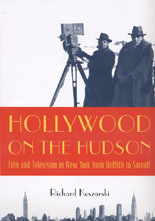(Rutgers University Press, 577 pages, $39.95)
By Richard Koszarski
 This huge, richly detailed revisionist history of the relationship between Hollywood and New York City from the turn of the 20th century until WWII is an enormously important, ceaselessly eye-opening work of Gotham-based cultural anthropology and archeology. Written by Rutgers University film professor Richard Koszarski, Hollywood on the Hudson is a New Yorker's passionate and unabashedly city-proud reclamation of the lost history of film production in the city, and a book that substantially reorients our understanding of American film history in an easterly direction.
This huge, richly detailed revisionist history of the relationship between Hollywood and New York City from the turn of the 20th century until WWII is an enormously important, ceaselessly eye-opening work of Gotham-based cultural anthropology and archeology. Written by Rutgers University film professor Richard Koszarski, Hollywood on the Hudson is a New Yorker's passionate and unabashedly city-proud reclamation of the lost history of film production in the city, and a book that substantially reorients our understanding of American film history in an easterly direction.
Conventional views of movie production in New York have tended to conform to the idea that, although early movie production in the United States was indeed centered in New York and northern New Jersey, by the end of the WWI Hollywood was established as the inarguable capital of American cinematic endeavor. By the mid-'30s, only intermittent and mainly independent productions were left behind in the East.
Yes, but that's not the whole picture, says Koszarski. He has spent 30 years disinterring the buried history of New York filmmaking, "most of it within commuting distance of Times Square." He reclaims stories of Astoria Studios in Queens and the studios of Fort Lee, NJ; of myth-shrouded production companies like Edison, Biograph and Vitagraph; of D.W. Griffith's self-financed studio complex at Mamaroneck on Long Island Sound; of the lost Yiddish cinema industry which thrived deep into the 1930s; and of the Sisyphean efforts of black filmmaking pioneer Oscar Micheaux and other minority artists. He recounts the city's rich history of newsreel and documentary films; animation pioneers (Max Fleischer, take a bow); and even the early, pre-WWII days of commercial television production at CBS.
Unlike early Hollywood, then still "a cultural wasteland with no professional theater, university, museum or art gallery," New York had a deep, life-giving cultural topsoil that fed umbilically into local cinema. Its studios weren't industrial entities, and location shooting with a distinctive documentary look was common. This resulted in a multifaceted variety of regional cinemas, and Koszarski seems to have uncovered it all. This book gives back to New York a continuous history of invention and creativity that, without Koszarski's Herculean labors, might have disappeared forever. Marvelous, invaluable, breathtaking film history.
Review written by John Patterson.